Montalcino is one of the most suggestive villages in Val d’Orcia, located North-West of Mount Amiata, in the province of Siena. The name comes from Latin “Mons Ilcinus”, that is “mount of holm oaks” (Quercus ilex L.), a very common species in the woods of the area, represented in the ancient emblem of the Municipality. Created in the 14th Century, with narrow and steep streets, Montalcino is rich in artistic and architectural treasure; located on the top of a hill, it is surrounded by an untouched landscape; it is so beautiful that it was inscribed in UNESCO’s World Heritage list in 2004.
Montalcino is famous for the production of honey, extra virgin olive oil, truffles, cured meats and cheeses, but above all for the Brunello, obtained from the San Giovese Grosso vineyard. The area is not foggy and there are no belated, while the frequent presence of wind guarantees the best conditions for the health of the vineyard. The climate is typically Mediterranean, with few rains concentrated in the months of March, April, November and December. The high number of clear days during the whole vegetative phase guarantees a gradual and complete ripening of the grapes.
The itinerary suggested will lead you to the discovery of the Montalcino territory through five very special wine companies, for their position, philosophy and respect of the environment: they are biological or biodynamic or follow the official biological guidelines and they pay great attention to the territory and to the trees. As a matter of fact, Stefano Lorenzi (arborist and tree climber certified by SIA, but also AIS sommelier and therefore connoisseur), who takes care of the big centenary trees in some of them, suggested them.
About this, Lorenzi says: “The concept of conservation of territory and biodiversity is more and more relevant and winemakers in particular are realising it, even more if they produce refined wines. The reason is simple on the surface: they are slowly realising that the territory hosting them is an important part of the creation of their “product”. Therefore, wine is not only the result of soil and vines, but also of all the necessary interaction that allow all of this to happen. In the districts where the territory was altered and industrialised too much, after a couple of years they realised that the product was losing identity and personality”.
On the contrary, it is important to recover these features: “Yes, first of all respecting the environmental balance that reigns: from the hedges in the vineyards that attract pollinating insects and birds, to the great multi-centenary trees that host local microorganisms and fauna, both in the roots and in the crown. In the past 5 years, I had the chance to meet some companies in the Montalcino territory who chose this theory of global conservation of the territory and to invest resources to take care of the big trees in their vineyards, to plant new trees and bushes and to pass these values on to their clients and final users. This awareness on my part and on the part of some of my colleagues goes on, trying to enlarge the platform of producers who understand that a tree in a farmstead is not a worthless expanse, ma a huge resource of biodiversity and territorial identity”.
To all this we must add that many winemakers offer also fascinating reception facilities: “They understood that trees create the landscape, what the tourist comes to admire. The latest fashion is ecotourism, therefore offering trekking among the vineyards, discovering majestic trees, can become interesting”.
MAP
The map shows the cellars of the itinerary suggested. For each cellar, we indicate its distance from the others, to make your journey easier. Visits and tastings must be booked in advance.

Ridolfi di Montalcino, località Mercatali 1, Montalcino (SI): on the North-East side of the hill of Montalcino (300 m above sea level) and near the renowned Strada del Brunello, here Tenuta Ridolfi extends for more than 54 hectares of land, of which 21 are occupied by the vineyard (11,4 Brunello, 6,5 Chianti Colli Senesi and 1 hectare Rosso di Montalcino), besides 700 olive trees of the variety ‘Correggiolo’. Its wines come from the determined search for excellence, heir of a noble Tuscan taste that remained intact through history.
Distance from other cellars: km 5 from Azienda Agricola L’Aietta – km 16 from Podere Le Ripi – km 16,5 from Azienda Agricola Mastrojanni – km 21 from Tenuta Val d’Orcia.
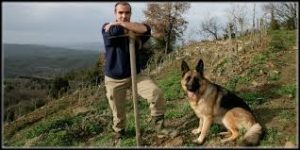
Azienda agricola L’Aietta, via Mazzini 42, Montalcino (SI): run by the young enthusiast Francesco Mulinari, with less than 2 hectares of land of which only 3000 m2 of Brunello, it is the smallest in Montalcino. Francesco has a clear idea: cultivate the land with the utmost respect for territory and tiniest intrusiveness possible. In fact, the company is biodynamic and, starting from 2015, all the work is done using only horses. “Among its wines, all very pleasant, there is an excellent Rosso di Montalcino that can be considered a high class Brunellino”, says Stefano Lorenzi.
Distance from other cellars: km 12 from Podere Le Ripi – km 5 from Ridolfi di Montalcino – km 12,5 from Azienda Agricola Mastrojanni – km 17 from Tenuta Val d’Orcia.
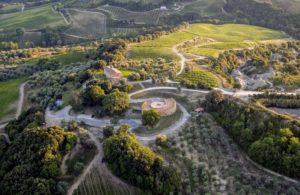
Podere le Ripi, località Le Ripi, Montalcino (SI): owned by Francesco Illy, it includes 54 hectares of woods, vineyards and olive groves, in an untouched land, with a wonderful vegetal diversity and a breath-taking view. You get to the company passing by a dirt road and it is run following the principles of biological agriculture and, from 2010, also biodynamic. The cellar has a beautiful architecture, a brick building facing Val d’Orcia and Mount Amiata. The wines are excellent and fresh, high quality, “among which one of the best Brunello I have ever tasted”, says Stefano Lorenzi. He takes care of the trees within the property, safeguarded by the owners as an added value to the territory. The tasting includes a tour of the vineyards and the explanation of the techniques implemented.
Distance from other cellars: km 0,5 from Azienda Agricola Mastrojanni – km 16 from Ridolfi di Montalcino – km 12 from Azienda Agricola L’Aietta – km 18 from Tenuta Val d’Orcia.
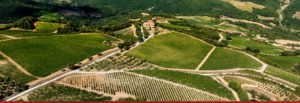
Azienda agricola Mastrojanni, Poderi Loreto e San Pio, Castelnuovo dell’Abate, Montalcino (SiI): it is one of the most traditional companies in Montalcino and it extends facing Mount Amiata and Val d’Orcia for 96 hectares, including a wood, of which 33 hectares of vineyard (17 of Brunello). It is managed by Andrea Machetti just as an old farmer would do: with respect for the territory and the knowledge that modern innovations must improve the quality of the product and not maximise profits. Vineyard and cellar are run following the principles and using the techniques of biological agriculture and the cellar has been recently expanded following the guidelines of bio-architecture. “The wines produced are highly refined and elegant, long living and classy”, says Stefano Lorenzi. The company is very attentive to a sustainable management and he was entrusted the care of the many monumental oaks in the property, and of a magnificent specimen in Podere Loreto in particular: “Rich in history, it fight to survive after it was hit by a lightning 20 years ago, but it is a centenary plant and it doesn’t give up, continuing to make beautiful this unique territory”. The old village in the property was recently restored and transformed into a relais well integrated within the landscape, with elegant stylistic choices, respectful of the old style.
Distance from other cellars: km 18,5 from Tenuta Val d’Orcia – km 16,5 from Ridolfi di Montalcino – km 12,5 from Azienda Agricola L’Aietta – km 0,5 from Podere Le Ripi.
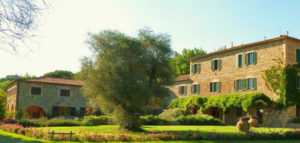
Tenuta Col D’Orcia, Via Giuncheti, Montalcino (SI): it is the biggest winemaking and agricultural company in Tuscany. The principles of biological agriculture are applied not only to the vineyards, but also to the olive groves, the fields, the park and the gardens. Thanks to its geographical position, the Brunello produced here distinguishes itself for its structure and elegance. From 1989 the company works with the Horticulture Department of the University of Florence, setting several experimentations. In 2018 it sponsored the Festival del Paesaggio (Landscape Festival), held in September in Sant’Angelo in Colle. In its lands there is the Quercia di Poggio di Vento, one of the most famous and important centenary oaks in Tuscany, entrusted to the care of arborist and tree climber Stefano Lorenzi and his team, who take care of pruning the biggest dry branches and of the biostimulation of roots, to help the plant face future extreme seasons.
Distance from other cellars: km 21 from Ridolfi di Montalcino – km 17 from Azienda Agricola L’Aietta – km 18 from Podere Le Ripi – km 18,5 from Azienda Agricola Mastrojanni.
Gardens and other things to discover in the area
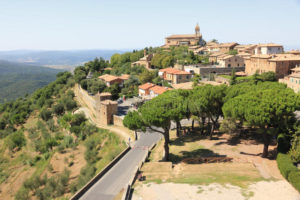
In the ancient village of Montalcino there are many monuments and works of art to admire, among which the masterpieces in the Museo Civico Diocesano d’Arte Sacra, such as the very rich collection of paintings and wooden sculptures of the Siena school, the 14th Century Sant’Agostino church, the neoclassical Cathedral, the Santuario della Madonna del Soccorso and Sant’Egidio, and, near Castelnuovo dell’Abate, the Sant’Antimo abbey, monumental structure of the 12th Century and one of the best examples of French Romanticism in Italy. But also:
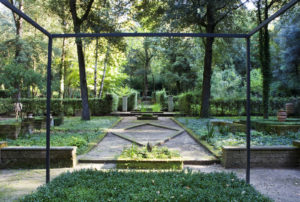
Il Bosco della Ragnaia, San Giovanni d’Asso (SI): this suggestive wood and garden was created by American painter and landscaper Sheppard Craige. Although included in a 18th Century “ragnaia”, it is a contemporary work begun in 1996 and still ongoing. Under its tall holm oaks you can find many inscriptions (some familiar, others enigmatic), fountains and concept sculptures, through these elements Craige united the nature of the place and the style of the Renaissance garden, creating a pleasant philosophical path about the biggest questions of man, but, actually, never taken too seriously by the sceptic and irreverent sense of humour of the artist. The Wood is open from March to November. Pay attention: it is strictly forbidden to smoke, scream and make distressing noises; group visits have to be authorized; dogs must be kept on a leash; children under the age of 14 are not welcome and must be accompanied by an adult.

Il Giardino di Graziella Soldera, località S. Restituta, Montalcino(SI): this pleasant garden was created by the owner, Mrs Graziella, botany and landscape architecture enthusiast, within Tenuta Case Basse. It is divided into thematic areas, grouping botanical species with similar needs, among which Il Giardino al Sole (Garden in the Sun), Il Giardino del Sottobosco (Undergrowth Garden) e il Giardino dei Fiori Bianchi (White Flower Garden), thought for nocturnal pollinators. The garden, surrounded by the Mediterranean shrub, with olive trees and centenary oaks, also hosts collection of flowering apple trees and roses, ancient ones in particular and forgotten varieties, searched and found by Graziella (also overseas), like the Rosa noisettiana ‘La Biche’. Visits must be booked in advance.
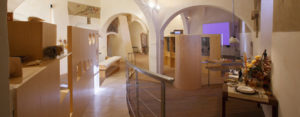
Museo del Tartufo, a San Giovanni d’Asso, Montalcino (SI): located within the 14th Century castle of the village, it follows a very funny sensorial path, that leads to the discovery of the precious tuber, up to the documentation centre where learning laboratories are held.


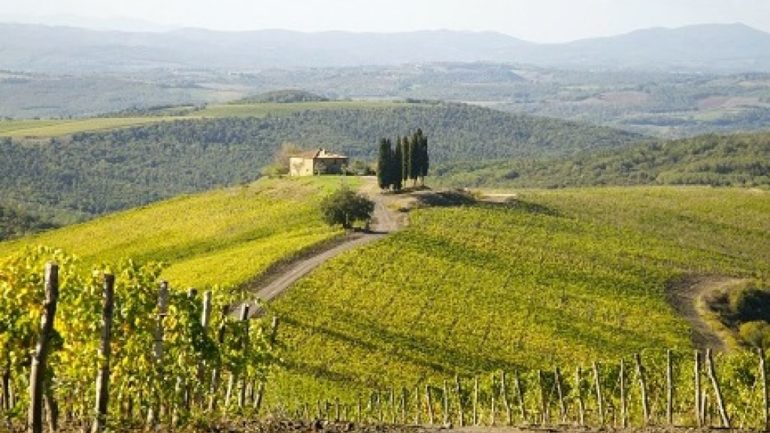


Rispondi